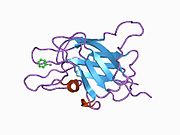Factor V
| F5 | |||
|---|---|---|---|
Gene ontology | |||
| Molecular function | |||
| Cellular component |
| ||
| Biological process | |||
| Sources:Amigo / QuickGO | |||
Ensembl | |||||||||
|---|---|---|---|---|---|---|---|---|---|
| UniProt | |||||||||
| RefSeq (mRNA) | |||||||||
| RefSeq (protein) | |||||||||
| Location (UCSC) | Chr 1: 169.51 – 169.59 Mb | Chr 1: 163.98 – 164.05 Mb | |||||||
| PubMed search | [3] | [4] | |||||||
| View/Edit Human | View/Edit Mouse |
Factor V (pronounced factor five) is a
Genetics
The
Structure
Factor V protein consists of six domains: A1-A2-B-A3-C1-C2.
The A domains are homologous to the A domains of the copper-binding protein ceruloplasmin, and form a triangular as in that protein. A copper ion is bound in the A1-A3 interface, and A3 interacts with the plasma.[6]
The C domains belong to the phospholipid-binding discoidin domain family (unrelated to C2 domain), and the C2 domain mediates membrane binding. The B domain C-terminus acts as a cofactor for the anticoagulant protein C activation by protein S.[7] [8]
Activation of factor V to factor Va is done by cleavage and release of the B domain, after which the protein no longer assists in activating protein C. The protein is now divided to a heavy chain, consisting of the A1-A2 domains, and a light chain, consisting of the A3-C1-C2 domains. Both form non-covalently a complex in a calcium-dependent manner. This complex is the pro-coagulant factor Va.[7]
Physiology
Factor V is produced by
Factor V is able to bind to activated platelets and is activated by thrombin. On activation, factor V is spliced in two chains (heavy and light chain with molecular masses of 110000 and 73000, respectively) which are noncovalently bound to each other by calcium. The thereby activated factor V (now called FVa) is a cofactor of the prothrombinase complex: The activated factor X (FXa) enzyme requires calcium and activated factor V (FVa) to convert prothrombin to thrombin on the cell surface membrane.
Factor Va is degraded by activated protein C, one of the principal physiological inhibitors of coagulation. In the presence of thrombomodulin, thrombin acts to decrease clotting by activating protein C; therefore, the concentration and action of protein C are important determinants in the negative feedback loop through which thrombin limits its own activation.
Role in disease
Various hereditary disorders of factor V are known. Deficiency is associated with a rare mild form of
There exists a bleeding tendency associated with the genetic up‐regulation of FV‐short, a minor splicing isoform of FV. This abnormal bleeding tendency occurs in east Texas bleeding disorder, Amsterdam bleeding disorder, and a third and more extreme example described in 2021 by Karen L. Zimowski et al.[11]
Other
History
Until the discovery of factor V, coagulation was regarded as a product of four factors:
The suggestion that an additional factor might exist was made by
The possibility of an extra coagulation factor was initially resisted on methodological grounds by Drs Armand Quick and Walter Seegers, both world authorities in coagulation. Confirmatory studies from other groups led to their final approval several years later.[12]
Owren initially felt that factor V (labile factor or proaccelerin) activated another factor, which he named VI. VI was the factor that accelerated the conversion from prothrombin to thrombin. It was later discovered that factor V was "converted" (activated) by thrombin itself, and later still that factor VI was simply the activated form of factor V.[12]
The complete amino acid sequence of the protein was published in 1987.[14] In 1994 factor V Leiden, resistant to inactivation by protein C, was described; this abnormality is the most common genetic cause for thrombosis.[15]
Interactions
Factor V has been shown to
References
- ^ a b c GRCh38: Ensembl release 89: ENSG00000198734 – Ensembl, May 2017
- ^ a b c GRCm38: Ensembl release 89: ENSMUSG00000026579 – Ensembl, May 2017
- ^ "Human PubMed Reference:". National Center for Biotechnology Information, U.S. National Library of Medicine.
- ^ "Mouse PubMed Reference:". National Center for Biotechnology Information, U.S. National Library of Medicine.
- ^ "F5 gene: MedlinePlus Genetics". medlineplus.gov. Retrieved 2023-03-25.
- PMID 9655335.
- ^ PMID 9632668.
- S2CID 4393638.
- PMID 31334957. Retrieved 7 February 2022.
- PMID 19141156.
- PMID 34176223.
- ^ PMID 12871488.
- PMID 20293060.
- PMID 3110773.
- S2CID 4314040.
- PMID 10593904.
- PMID 8428962.
Further reading
- Nicolaes GA, PMID 11950687.
- Segers K, Dahlbäck B, Nicolaes GA (September 2007). "Coagulation factor V and thrombophilia: background and mechanisms". Thrombosis and Haemostasis. 98 (3): 530–42. S2CID 29406966.
- Hooper WC, De Staercke C (2006). "The relationship between FV Leiden and pulmonary embolism". Respiratory Research. 3 (1): 8. PMID 11806843.
- Schrijver I, Houissa-Kastally R, Jones CD, Garcia KC, Zehnder JL (February 2002). "Novel factor V C2-domain mutation (R2074H) in two families with factor V deficiency and bleeding" (PDF). Thrombosis and Haemostasis. 87 (2): 294–99. S2CID 4818866. Archived from the original(PDF) on 2019-03-07.
- Mann KG, Kalafatis M (January 2003). "Factor V: a combination of Dr Jekyll and Mr Hyde". Blood. 101 (1): 20–30. S2CID 8885302.
- Duga S, Asselta R, Tenchini ML (August 2004). "Coagulation factor V". The International Journal of Biochemistry & Cell Biology. 36 (8): 1393–99. S2CID 27193482.
- Andreassi MG, Botto N, Maffei S (2006). "Factor V Leiden, prothrombin G20210A substitution and hormone therapy: indications for molecular screening". Clinical Chemistry and Laboratory Medicine. 44 (5): 514–21. S2CID 34399027.
- Du X (May 2007). "Signaling and regulation of the platelet glycoprotein Ib-IX-V complex". Current Opinion in Hematology. 14 (3): 262–69. S2CID 39904506.
External links
- The Coagulation Factor V Protein
- Overview of all the structural information available in the PDB for UniProt: P12259 (Coagulation factor V) at the PDBe-KB.



